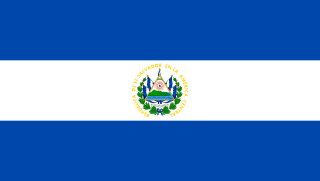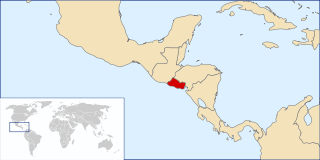
El Salvador has transport links by road, rail, sea and air.
This page provides an index of articles on rail transport by country.

An elevated railway or elevated train is a railway with the tracks above street level on a viaduct or other elevated structure. The railway may be broad-gauge, standard-gauge or narrow-gauge railway, light rail, monorail, or a suspension railway. Elevated railways are normally found in urban areas where there would otherwise be multiple level crossings. Usually, the tracks of elevated railways that run on steel viaducts can be seen from street level.

Guatemala had a network of 914 mm narrow gauge railroads.

As of 2022, no trains are operated in El Salvador. The national railroad corporation is FENADESAL, a division of CEPA. It oversees 554.8 km of all disused 3 ft narrow gauge lines connecting major cities and formerly linked with Guatemala railroads at Anguiatú.

Rail transport in Central America consists of several isolated railroad lines with freight or passenger service. The most famous one is the Panama Canal Railway, the oldest transcontinental railroad in the world, connecting Panama City with Colón since 1855. Other railroads in Belize, Guatemala, Honduras, El Salvador, Nicaragua, Costa Rica and Panama were built by private and public investors mainly to facilitate the transport of local agricultural produce to export markets and harbors. Their market share and profitability went into decline in the second half of the twentieth century and most lines have been decommissioned by the end of the 1990s. As of 2018, railroads operate locally in Honduras, Costa Rica and Panama only; all rail transport has been suspended in Belize, El Salvador, Guatemala and Nicaragua. The railways still operating do not cross national borders.

El Salvador – sovereign country located on the Pacific Coast of Central America. The area was originally called by the Pipil "Cuzcatan", in Spanish "Cuzcatlan", which in Nahuat means "The Land Of Precious Things". After the Spanish conquest, the land was divided into the province of San Salvador and the province of Izalcos ; until in 1824 the two jurisdictions were united in the State, now Republic, of El Salvador. The country borders the Pacific Ocean between Guatemala and Honduras. With a population of approximately 5.8 million people, it is the most densely populated nation in Central America and is undergoing rapid industrialization.

The following outline is provided as an overview of and topical guide to Honduras:
Ricardo García Posada Airport, formerly El Salvador Bajo Airport, is an airport serving the copper mining community of El Salvador, in the Atacama Region of Chile.

The following is an alphabetical list of topics related to the Republic of El Salvador.

This is an index of Central America-related articles. This index defines Central America as the seven nations of Belize, Costa Rica, El Salvador, Guatemala, Honduras, Nicaragua, and Panama.
Barrillas Airport is an airport serving Puerto Barillas, a small-craft dockage on an arm of the Bahia de Jiquilisco, 10 kilometres (6.2 mi) southwest of Usulután in Usulután Department, El Salvador.
Ceiba Doblada Airport is an airstrip serving the village of Ceiba Doblada in Usulután Department, El Salvador. The unmarked grass runway is 8 kilometres (5.0 mi) east of the village.
Corral De Mulas Airport is an airport serving the village of Corral De Mulas in Usulután Department, El Salvador. The unmarked grass runway is west of and adjacent to the village.
El Jocotillo Airport is an airport serving several small towns and villages in southern Sonsonate Department, El Salvador. The largest nearby city is the Pacific coastal port of Acajutla, at 10 kilometres (6.2 mi) west.
Espiritu Santo Airport is an airstrip serving the village of Espiritu Santo in Usulután Department, El Salvador. The runway is on a point in the Bahia de Jiquilisco.
El Zapote Airport is an airport serving the village of El Zapote in Ahuachapán Department, El Salvador. The runway is located on the Barra de Santiago at the mouth of the Rio Aguachapío.
La Cabaña Airport is an airstrip serving the town of La Cabaña. It is located in the municipality of El Paisnal in San Salvador Department, El Salvador.
La Chepona Airport is an airstrip serving the village of La Chepona in Usulután Department, El Salvador. The airstrip and village are on an estuarian island just east of the Jiquilisco Bay.
La Carrera Airport is an airport serving the city of Jiquilisco in Usulután Department, El Salvador. The runway is 5 kilometres (3.1 mi) east of Jiquilisco.









